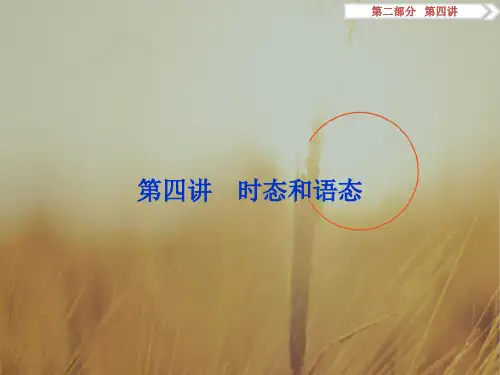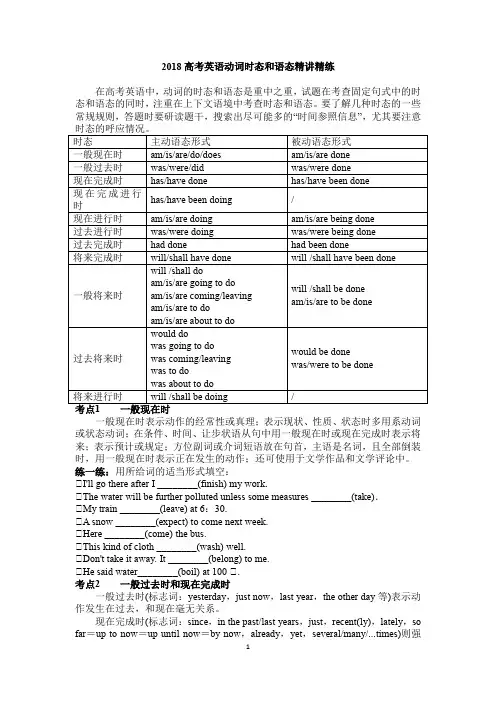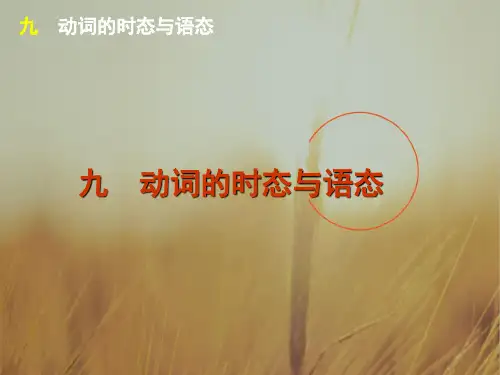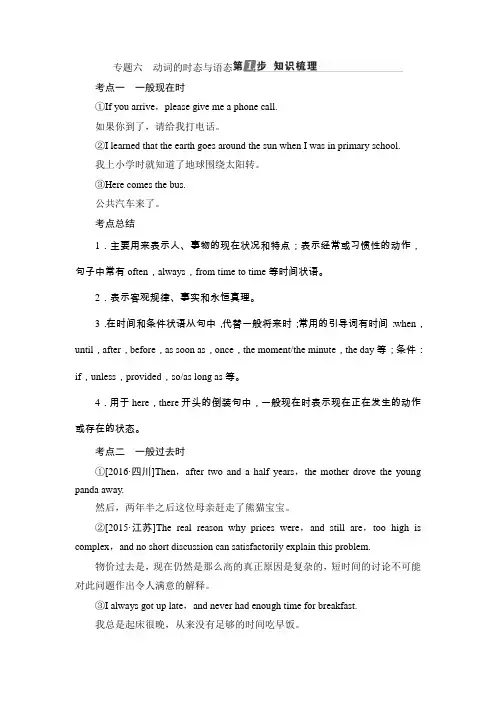2018届高考必考语法精讲之动词时态和语态(word版)复习过程
2018高考英语总复习课件:第二部分第四讲 时态和语态

常用完成时的句型
句型 It is/has been+一段时间+ since从句. (since从句用一般
3.完成进行时 完成进行时表示从过去某一时刻开始, 一直持续到现在的 动作。 这一动作可能刚完成, 也可能仍在进行, 具有持续 性和未完成性。 该时态多用于延续性动词。
The manager has been telling the workers how to improve the program since 9 a. m.从上午9点开始, 经理就一直在 告诉工人们如何改进这个项目。
(2)短暂性动词可用过去进行时表示过去按计划、 安排要做 的事。
I was coming to visit you later that day, but I had to phone and cancel. 我本打算那天晚些时候去看你, 但是我不得不 打电话取消了。
3. 将来进行时 表示将来某时或某一时段正在进行的动作, 常表示事情的 正常发展。 —Can I call you back at two o’clock this afternoon? ——今天下午两点我给你回电话可以吗? —I’m sorry, but by then I will be flying to Beijing. How about five? ——对不起, 那时我正飞往北京, 五点钟怎么样?
I walked slowly through the market, where people were selling all kinds of fruits and vegetables. I studied the prices carefully and bought what I needed. 我慢慢地走过一个市场, 人们在那里销售各种各样的水果 与蔬菜。 我认真地研究了它们的价格之后, 买了些我所需 要的。
2018年高考英语语法复习精讲三(动词时态和语态)

2018高考英语动词时态和语态精讲精练在高考英语中,动词的时态和语态是重中之重,试题在考查固定句式中的时态和语态的同时,注重在上下文语境中考查时态和语态。
要了解几种时态的一些常规规则,答题时要研读题干,搜索出尽可能多的“时间参照信息”,尤其要注意一般现在时表示动作的经常性或真理;表示现状、性质、状态时多用系动词或状态动词;在条件、时间、让步状语从句中用一般现在时或现在完成时表示将来;表示预计或规定;方位副词或介词短语放在句首,主语是名词,且全部倒装时,用一般现在时表示正在发生的动作;还可使用于文学作品和文学评论中。
练一练:用所给词的适当形式填空:①I'll go there after I ________(finish) my work.②The water will be further polluted unless some measures ________(take).③My train ________(leave) at 6:30.④A snow ________(expect) to come next week.⑤Here ________(come) the bus.⑥This kind of cloth ________(wash) well.⑦Don't take it away. It ________(belong) to me.⑧He said water________(boil) at 100 ℃.考点2一般过去时和现在完成时一般过去时(标志词:yesterday,just now,last year,the other day等)表示动作发生在过去,和现在毫无关系。
现在完成时(标志词:since,in the past/last years,just,recent(ly),lately,so far=up to now=up until now=by now,already,yet,several/many/...times)则强调的是对现在的影响和结果,动作到现在刚完成或还在继续。
2018年高考英语外研版一轮复习课件:语法专项 一、动词的时态和语态 精品

【典例剖析】用所给词的适当形式填空 (2016·北京高考)Jack______(work)in the lab when the power cut occurred.
解题关键: 根据句意“Jack正在实验室工作的时候突然 停电了。”以及关键词occurred可知, 此句型是 was/were doing. . . when. . . 结构。 答案判定: was working
现在进 主要用于表示目前或现阶段正在进行的动作 行时 或状态, 常跟时间状语now, at present等连用
*He usually writes a lot of letters, but he isn’t writing at present.
【典例剖析】用所给词的适当形式填空 (2015·北京高考)I______(write)to tell you my exciting plan for the summer holiday.
(2)在时间、条件等状语从句中常用一般过去时代替过 去将来时。 *He said he would not go if it rained. (3)表达“原以为/本来认为/原希望”等意义时, know, think, expect等动词常用一般过去时。 *I didn’t expect to meet you here. 我没料到会在这里碰见你。
③be about to do sth. 表示即将要发生某事。该结构通 常不与具体的时间状语连用。 *The train is about to leave.
【典例剖析】用所给词的适当形式填空 (2015·全国卷Ⅱ)If you are able to come with us, please let us know and we________(wait)for you at the school gate at 9 in the morning.
2018版高考英语全国版大一轮复习应试基础必备+高考考法突破课件:专题10 动词、动词的时态和语态

【特别注意】
分考点2 常考动词的固定结构
stop还可用于stop doing sth.(停止做某事)和stop to do sth. (停下来去做某事)结构。keep还可用于keep doing sth.(继续做 某事)和keep sb. doing sth.(让某人一直做某事)结构。
·At age 68, he retired from the post office, but he never stopped serving the community. 他68岁时从邮局退休了,但他从未停止为社区服务。[天津2015]
accuse控告 remind使想起 suspect怀疑
cheat欺骗 rob抢劫 persuade说服
cure治愈
inform通知
warn警告
rid使摆脱
convince使信服
·This photo reminds me of my school days. 这张照片使我想起了我的学生时代。 ·The fellow robbed me of my wallet on the bus. 那个家伙在公交车上抢了我的钱包。 ·You’ll need to convince them of your enthusiasm for the job. 你要使他们相信你对这份工作的热情。
分考点1 一般现在时
(3)表示客观事实、普遍真理及自然现象,或用在格言中。 ·“Life is like walking in the snow,” Granny used to say, “because every step shows.”奶奶过去经常说:“人生就像在雪中行走,因为 每一步都留有足迹。”[课标全国] ·The earth goes round the sun. 地球绕着太阳转。 ·Failure is the mother of success.失败是成功之母。
广东省广州市2018高考高三英语语法一轮复习精讲精练课件:单项填空动词的时态与语态 含答案

A.travels
B.traveled
C.would travel
D.was traveling
【解析】 A 宾语从句的时态通常要与主句的时态保持一 致,但表示客观真理时通常用一般现在时。
.九 │ 模拟试题
( )8.—Is this the last exam we have to take this
九 动词的时态与语态
九 动词的时态与语态
九 │ .导读
导读
动词的时态与语态是历年高考试题中考查最多的,其中 主要集中在动词的时态,或语态以及时态语态结合起来考查。 此类题目在高考题中时态占的比例非常大,有的省(市)在 一套题目中多达三个时态题。高考对被动语态的考查热点主 要是及物动词的被动语态的应用。对近几年的时态考查范围 多集中在一般现在时、现在进行时、一般过去时、过去进行 时以及过去完成时上。
.九 │ 题例精讲
( )5.Tom ________in the library every night over
the last three months.
A.works
B.worked
C.has been working
D.had been working
【解析】 C 句意:过去的三个月里,汤姆每天晚上都在 图书馆工作。考查动词时态辨析。根据时间状语every night over the last three months可知用现在完成进行时,故选择C项。
.九 │ 题例精讲
( )4.Experiments of this kind ______in both the
U.S. and Europe well before the Second World War.
2018版高考英语语法 动词的时态与语态

专题六动词的时态与语态考点一一般现在时①If you arrive,please give me a phone call.如果你到了,请给我打电话。
②I learned that the earth goes around the sun when I was in primary school.我上小学时就知道了地球围绕太阳转。
③Here comes the bus.公共汽车来了。
考点总结1.主要用来表示人、事物的现在状况和特点;表示经常或习惯性的动作,句子中常有often,always,from time to time等时间状语。
2.表示客观规律、事实和永恒真理。
3.在时间和条件状语从句中,代替一般将来时;常用的引导词有时间:when,until,after,before,as soon as,once,the moment/the minute,the day等;条件:if,unless,provided,so/as long as等。
4.用于here,there开头的倒装句中,一般现在时表示现在正在发生的动作或存在的状态。
考点二一般过去时①[2016·四川]Then,after two and a half years,the mother drove the young panda away.然后,两年半之后这位母亲赶走了熊猫宝宝。
②[2015·江苏]The real reason why prices were,and still are,too high is complex,and no short discussion can satisfactorily explain this problem.物价过去是,现在仍然是那么高的真正原因是复杂的,短时间的讨论不可能对此问题作出令人满意的解释。
③I always got up late,and never had enough time for breakfast.我总是起床很晚,从来没有足够的时间吃早饭。
秘籍04 动词的时态和语态-2018年高考英语抢分秘籍 Word版含解析
秘笈04 动词的时态和语态1. 了解并能正确运用常考的11种时态;2. 熟练运用现在完成时、现在完成进行时、一般过去时等高考高频时态;3. 掌握几种易混时态的区别,如现在完成时和一般过去时等。
动词时态的知识网络(以动词do为例)一般时包括一般现在时、一般过去时、一般将来时和一般过去将来时。
一、一般现在时1. 一般现在时的构成一般现在时主要用动词原形来表示。
主语是第三人称单数时,动词后面要加-s或-es。
☞They want good jobs.他们想要好的工作。
☞The coat matches the dress.外衣和裙子很相配。
☞This work does not satisfy me.这项工作我不满意。
☞Do you understand?你懂了吗?2. 一般现在时的用法①一般现在时的基本用法a. 表示现在习惯性的动作或存在状态☞He always takes a walk after supper.晚饭后他总是散散步。
☞Everyone is in high spirits now.现在大家都情绪高涨。
b. 表示客观事实或普遍真理☞The sun rises in the east and sets in the west.太阳从东方升起在西方落下。
☞Sound travels faster through water than it does through air.声音在水中的传播速度要比在空气中快。
☞Time and tide wait for no man.时间不等人。
c. 表示主语的特征、能力和状态☞This cloth feels soft.这布摸上去很软。
☞I love classical music.我喜欢古典音乐。
☞The President still seems able to find time to go fishing.看来总统仍能有时间去钓鱼。
d. 表示按计划或安排将要发生的动作☞The meeting begins at 7:00.会议七点钟开始。
2018高考英语一轮复习课件 专题六 时态、语态 精品
2.表示客观真理、科学事实。 ►The sun rises in the east and sets in the west. 太阳从东方升起,从西方落下。 3.可用在由 if,unless 引导的条件状语从句;由 even if/though 引导的让步状语 从句;由 when,before,until/till,as soon as,the moment 引导的时间状语从句;由 no matter what/who/when/where/how 或 whatever,whoever 等引导的让步状语从句中, 这时主句往往用一般现在时表将来。主句还可以是祈使句。 ►Whatever you say,I will not change my mind. 无论你说什么,我都不会过去的事情、动作或状态,常与表示过去的时间状语连用(或上 下文语境有暗示);还可用于表示过去的习惯。表达“原以为/本来认为/原希望”等意 义时,know,think,expect 等动词常用一般过去时。 ►(湖南高考)In 1492,Columbus landed on one of the Bahama Islands,but he mistook it for an island off India. 1492 年哥伦布登上了巴哈马群岛中的一个岛屿,但是他却把它误当作是印度附 近的一个岛屿。 ►—I didn't expect to meet you here.——我没料到会在这里碰见你。
动词的时态和语态-2018年初高中英语教材衔接+Word版含解析
【知识衔接】————初高中课程解读————————初中知识回顾————一.动词的时态1.一般现在时(1)一般现在时的基本结构:当主语是第三人称单数时,谓语动词用第三人称单数形式。
动词的第三人称单数形式变化规则如下:①直接加-s。
如:work—works。
②以“辅音字母+y”结尾的词,先变y为i,再加-es。
如:carry—carries; cry—cries; try—tries; study—studies。
③以s,x,o,ch,sh结尾的词加-es。
如:wash—washes; teach—teaches; go—goes; pass—passes; fix—fixes。
④特殊:have—has;be→is。
(2)一般现在时的用法:①表示事实、现状、性质或经常性、习惯性的动作。
常与seldom, often, usually, always, sometimes, today, every day, once a week, every five minutes, on Sundays等时间状语连用。
I go to school at seven every day. 我每天七点去上学。
②表示普遍真理和客观事实。
The earth goes around the sun. 地球绕着太阳转。
③表示在现在时间里所发生的一个动作。
Here comes the bus. 公共汽车来了。
④在时间和条件状语从句中代替一般将来时。
I'll go shopping with my mother if she is free tomorrow.如果明天我妈妈有空的话,我将和她去购物。
(3) 一般现在时的疑问句、否定句Do you see the bird in the tree? 你看见树上的鸟了吗?2.一般过去时(1)一般过去时的用法及标志词一般过去时表示过去发生的动作或存在的状态。
句中的谓语动词要变为过去式。
动词的时态与语态 (2018高考英语,Word版含详解)
动词的时态和语态2018.01 Ⅰ.单句语法填空1.(2015·北京,22改编)—Did you enjoy the party?—Yes,We__were_treated__(treat) well by our hosts.解析:根据上下文,这里谈的是举行过的一次聚会,应该用过去时,并且“我们”是被主人招待的,所以需用一般过去时的被动语态。
句意:——你喜欢这个聚会吗?——是的,我们的主人很好地招待了我们。
2.(2015·北京,26改编)In the last few years,China__has_made__(make) great achievements in environmental protection.解析:时间状语in/over the last few years通常与现在完成时连用。
句意:在过去的几年中,中国在环境保护方面取得了巨大成就。
3.(2015·北京,30改编)—Dr.Jackson is not in his office at the moment.—All right.I__will_call__(call) him later.解析:据第一句的时态判断,Dr. Jackson目前不在办公室,所以打电话是将来的事。
句意:——Dr. Jackson现在不在办公室。
——好的,我待会再给他打。
4.(2015·天津,6改编)Jane can't attend the meeting at 3 o'clock this afternoon because she__will_be_teaching__(teach) a class at that time.解析:根据题干时间状语3 o'clock this afternoon的提示可知,动作发生时间为将来;而句尾的at that time为一个特定的时间点,因此,该题强调在将来的大时间背景下的某一个特定时间点发生的事,故用将来进行时。
- 1、下载文档前请自行甄别文档内容的完整性,平台不提供额外的编辑、内容补充、找答案等附加服务。
- 2、"仅部分预览"的文档,不可在线预览部分如存在完整性等问题,可反馈申请退款(可完整预览的文档不适用该条件!)。
- 3、如文档侵犯您的权益,请联系客服反馈,我们会尽快为您处理(人工客服工作时间:9:00-18:30)。
2018届高考必考语法精讲之动词时态和语态(w o r d版)精品文档2018 届高考必考语法精讲:动词的时态和语态语法中的时态(tense)是一种动词形式,同一动词的不同变化形式表达不同的时态,英语中有16 种时态。
《2017年普通高等学校招生全国统一考试大纲》附录语法项目表中对于时态列了十项:(1)一般现在时(2)一般过去时(3)一般将来时(4)现在进行时(5)过去进行时(6)过去将来时(7)将来进行时(8)现在完成时(9)过去完成时(10)现在完成进行时;此外还列了被动语态,并将其作为单独一项。
2015 年高考全国卷Ⅰ第61 题(语法填空)考查了动词arrive 的一般过去时arrived;第71 题(短文改错)考查了think 变为过去时thought;第75 题(短文改错)考查了被动语态,删掉been;第79 题(短文改错)考查了将动词过去时的found 变为现在时的find。
2016 年高考全国卷Ⅰ第62 题(语法填空)考查了allow 的一般过去时的被动语态was allowed;第74 题(短文改错)考查了将过去时had 变为现在时的have;77 题(短文改错)考查了将using 变为被动used。
2017 年高考全国卷Ⅰ第64 题(语法填空)考查了remove 的一般现在时的被动语态are removed;第74 题(短文改错)考查了将动词goes 变成一般过去时went。
各种时态构成表:(以do 为例)一般时态进行时态完成时态完成进行时态现在do/does is/am/are doing has/have done has/have been doing过去did was /were doing had done had been doing将来shall/will do shall/will be doing shall/will have done shall/will have been doing过去将来would do would be doing would have done would have been doing一、一般现在时:动词原形或第三人称单数1.构成:使用动词原形,第三人称单数须有变化。
(1)直接加“s”:work→works,take→takes(2)以辅音加“y”结尾,变“y”为“i”,再加“es”:carry→carries(3)以“o, s, x, ch, sh”结尾的动词加“es”:go→goes,dress→dresses,watch→watches,finish→finishes2.功能:(1)表现在的事实、状态或动作。
例如:①I have a dream.②She loves music.③Mary's parents get up very early.(2)表习惯性动作或职业,常与often,sometimes,usually,always,every week,occasionally,frequently,seldom 等时间副词连用。
例如:精品文档①I always take a walk after supper.②She writes to me very often.③She is an English teacher.(3)表客观真理,格言警句或事实。
例如:①The earth moves around the sun.②The sun rises in the east and sets in the west.③Two and two makes four.④No man but errs.(4)表示将来发生的动作:A.在由when,after, before,as,as soon as,although,because,if,even if,in case,till,until,unless,as long as,where,whatever,wherever 等引导的状语从句中用一般现在时表将来发生的动作。
例如:①I'll tell her when she comes tomorrow.②Even if it rains this afternoon, I'll meet you.③Whatever happens, you should keep cool-headed.④I'll be right here waiting for you wherever you go.B.按时间表将要发生的动作或事件,用一般现在时表达将来时概念。
例如:①The play begins at 6:30 this evening.②When does the plane take off?③He leaves for that city next week.④According to the timetable, the train starts at 9 o’clock.二.一般过去时:动词的过去式1.表示过去某个特定时间或某一段时间发生的动作或情况。
例如:①We visited the school last spring.②I went to school by bike when I was in middle school.③China was founded in 1949.2.在表示时间或条件等的状语从句中代替过去将来时。
例如:①She told me she would’t go with us if it rained the next day.②They would not leave until she came back.③His girlfriend promised to marry him once he bought her a big house.三.一般将来时:shall / will + 动词原形1.表示将要发生的动作或存在的状态。
例如:①He will graduate from the college next year.精品文档②We shall finish our work as quickly as possible.2.将来时的其它结构。
例如:I .is/am/are going to do sth.(美国口语中常读作be gonna)①I'm going to buy a new car this fall.②He is going to sell his house.注意:be going to 与will 的对比:下列情况须用will①I will be sixteen years old next year.②It will be the 20th of August tomorrow.③When he comes, I will give him your message.II. is/am/are + to do sth.表示计划安排做某事或征求意见。
例如:①Am I to take over his work?②We are to meet at the gate.III. is/am/are about to do sth. 即将做某事。
例如:①The talk is about to begin.四.一般过去将来时:would + 动词原形1.表示过去某时之后将出现的情况,通常用于宾语从句中。
例如:①He said that they would meet me at the station.②She told me that she would come to see me.2.表示过去习惯性动作(不管什么人称都用would)。
例如:①Whenever he had time,Tom would go to see his grandma.②The old couple would go for a walk after supper.注意句型:was/were about to do sth. when……正要做某事,这时……=was/were on the point of doing sth. when……(when 引导的从句要用一般过去时)例如:①He was about to go out when the telephone rang.②I was about to go shopping when it rained.③She was on the point of having supper when the light went off.五.现在进行时:is / am / are +现在分词1.表示现在正在进行的动作。
例如:①The water is boiling. Shall I make tea?②The workers are building a new bridge across the river.2.表现阶段正进行的动作。
例如:①He is taking physics this semester.②We are preparing for our final examination this week.③Don't you think you eat too much? You're putting on weight.3.go, come, leave, arrive, land, meet, die, start, return, join, etc.用于进行时态时表示即将开始的动作。
例如:①Look! The bus is coming.②The old man is seriously ill, and he is dying.③Alice is leaving for Shanghai with her mother.4.与always, forever, continually, constantly 等副词连用,表示说话人带有感情色彩:赞赏或厌恶。
例如:①He is always thinking of others.②The boy is continually making noises.③The teacher is constantly criticizing her for being late.六.过去进行时:was /were +现在分词1.表示过去某一时刻或阶段正在发生的动作。
例如:①I was playing chess at 8 yesterday evening.②When I arrived, they were watching TV.③They were doing housework this time last week.2.用于条件状语从句中表示过去将来进行的动作。
